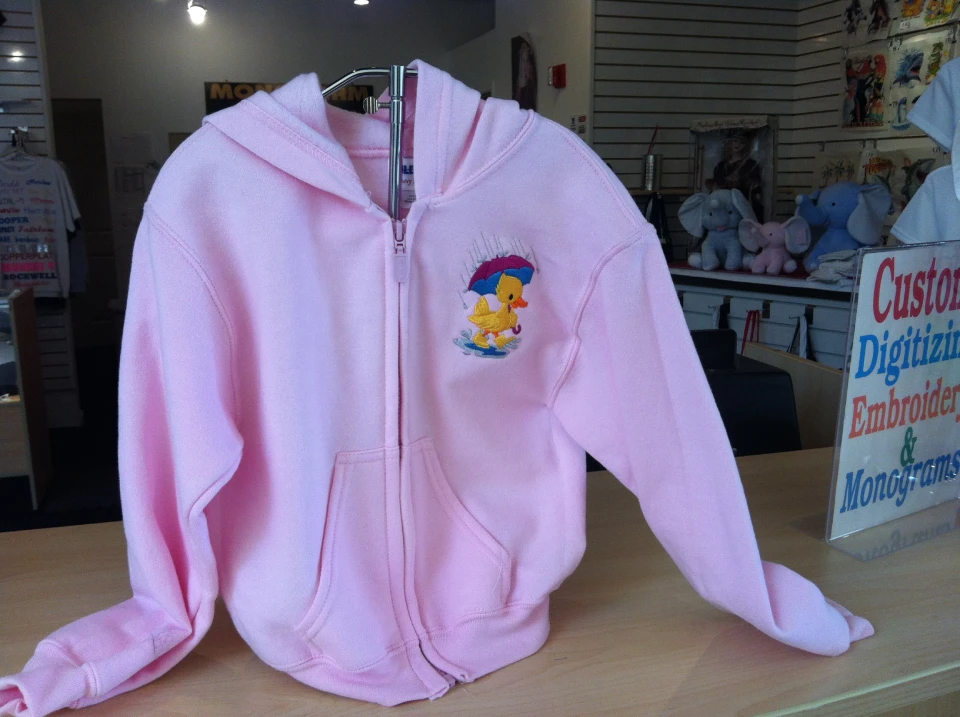Customized Lab Coats with Embroidery for Medical Professionals
Customized Lab Coats with Embroidery for Medical Professionals
Blog Article
The Art of Custom Needlework: Unlocking the Tricks to Creating Unique and Unforgettable Styles
Embroidery, a craft soaked in practice and artistry, holds within its intricate stitches the power to transform fabric into a canvas of distinct expression. The keys to developing personalized embroidery designs that astound the eye and leave a lasting impact lie in a fragile balance of technique, creative thinking, and attention to information. As we dig right into the globe of custom embroidery, we discover the nuanced interaction in between string selection, stitch intricacy, and style personalization that elevates a plain garment to a masterpiece. Join us on a journey through the art of custom needlework as we untangle the enigmas behind crafting genuinely memorable and distinct developments.
Selecting the Right Embroidery Threads
When picking needlework threads, what vital factors should you take into consideration to guarantee the most effective results for your custom-made designs? The choice of needlework thread is essential in determining the last result of your embroidered design. Among the primary factors to consider is the product of the string. Different products such as cotton, polyester, rayon, and silk offer differing degrees of shine, sturdiness, and appearance. It is important to select a string product that enhances the material you are embroidering on and lines up with the wanted appearance of the style.
Furthermore, the weight or density of the thread plays a substantial duty in the look of the needlework. Thicker threads can include measurement and texture to your style, while finer strings are suitable for complex information and little message. In addition, thinking about the shade fastness and washability of the string is important to make sure that your custom-made designs keep their high quality and vibrancy in time. By meticulously reviewing these factors and choosing high-grade strings that meet your certain demands, you can improve the visual allure and long life of your stitched creations.
Discovering Different Stitch Techniques
To look into the realm of 'Checking out Various Stitch Methods', one need to realize the ins and outs and nuances that each sewing approach offers the art of needlework. Various stitch methods not only include aesthetic passion but also contribute to the general texture and dimension of the design. One preferred stitch technique is the satin stitch, which involves very closely stuffed parallel stitches to produce a smooth and glossy surface area, ideal for filling up in shapes and producing vibrant describes.
On the other hand, the backstitch is a functional strategy commonly used for outlining and including fine details. It entails stitching backward to develop a strong line of needlework. Furthermore, the French knot stitch adds a responsive component to layouts, ideal for developing distinctive accents like flower facilities or decorative touches.
Discovering various stitch methods allows embroiderers to have fun with light, shadow, and depth within their styles, raising the aesthetic allure and creative high quality of their embroidery projects. By mastering various sewing techniques, one Going Here can unlock endless opportunities for developing special and memorable custom needlework pieces.
Incorporating Personalized Design Elements
Having discovered the intricacies of different stitch methods such as the satin stitch, backstitch, and French knot, the focus currently shifts in the direction of integrating customized design components in personalized needlework tasks. Customized layout aspects play a vital duty in making embroidery projects really special and unforgettable.
Another means to integrate personalized style components is by including signs or concepts that hold special significance to the recipient or reflect their rate of interests and personality. Integrating a favorite flower, pet, or hobby-related sign can make the embroidery design extra meaningful and customized. Furthermore, picking shades that resonate with the recipient or straighten with the designated theme can even more boost the personalization of the embroidery job.
Grasping the Art of Color Sychronisation

One key element of shade control is recognizing color theory. This includes knowing just how various shades connect with each other, the feelings they share, and just how they can be combined to create aesthetically enticing designs. By using color concept concepts, embroiderers can develop harmonious shade combinations that boost the total look of the design.
Furthermore, taking you could try this out note of comparison is essential in color coordination. Utilizing contrasting shades can assist particular components of the layout pop, improve legibility, and create an aesthetically dynamic needlework piece. By mastering the art of color control, embroiderers can boost their designs and create remarkable items that reverberate with customers and visitors alike.
Enhancing Appearance With Advanced Embroidery Stitches

French knots, as an example, are ideal my sources for including tiny, increased dots to your style, resembling the appearance of beads or creating a textured surface area. Bullion knots, on the other hand, can be used to produce twisted, ropelike components that include an elegant feeling to the needlework. Seed stitching entails tiny, scattered stitches that can fill up in locations with a multicolor texture, while turkey job develops cosy, dimensional accents evocative pet hair or foliage. Trying out with these innovative needlework stitches enables you to press the boundaries of traditional embroidery and produce genuinely distinct and aesthetically enticing structures in your layouts.
Verdict
In final thought, the art of personalized embroidery includes a mix of selecting the ideal strings, checking out numerous stitch methods, including individualized layout aspects, mastering shade control, and boosting appearance with innovative stitches. By recognizing and applying these crucial components, embroiderers can create unique and remarkable designs that display their creative thinking and skill. Embroidery enthusiasts can open the tricks to developing gorgeous and bespoke items that attract attention and leave a long-term perception.
Report this page